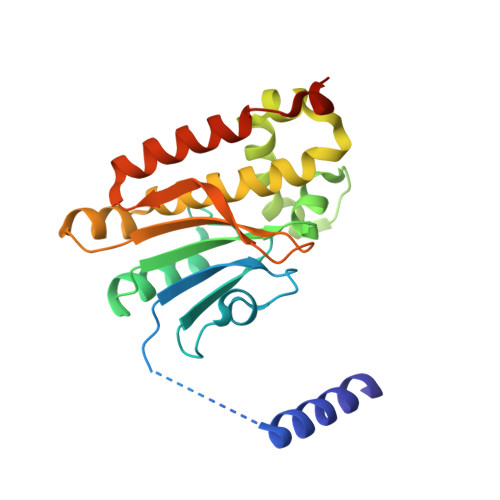Evidence for a bicarbonate "escort" site in Haemophilus influenzae beta-carbonic anhydrase .
Rowlett, R.S., Hoffmann, K.M., Failing, H., Mysliwiec, M.M., Samardzic, D.(2010) Biochemistry 49: 3640-3647
- PubMed: 20359198
- DOI: https://doi.org/10.1021/bi100328j
- Primary Citation of Related Structures:
3E2X, 3E31, 3E3F, 3E3G, 3E3I - PubMed Abstract:
The Haemophilus influenzae beta-carbonic anhydrase (HICA) allosteric site variants V47A and G41A were overexpressed and purified to homogeneity. These variants have k(cat)/K(m) values similar to that of the wild-type enzyme and exhibit a similar dramatic decrease in catalytic activity at pH <8.0. However, both HICA-G41A and -V47A were serendipitously found to bind sulfate ion or bicarbonate ion near pairs of Glu50 and Arg64 residues located on the dimerization interface. In the case of HICA-V47A, bicarbonate ions simultaneously bind to both the dimerization interface and the allosteric sites. For HICA-G41A, two of 12 chains in the asymmetric unit bind bicarbonate ion exclusively at the dimerization interface, while the remaining 10 chains bind bicarbonate ion exclusively at the allosteric site. We propose that the new anion binding site along the dimerization interface of HICA is an "escort" site that represents an intermediate along the ingress and egress route of bicarbonate ion to and from the allosteric binding site, respectively. The structural evidence for sulfate binding at the escort site suggests that the mechanism of sulfate activation of HICA is the result of sulfate ion competing for bicarbonate at the escort site, preventing passage of bicarbonate from the bulk solution to its allosteric site.
Organizational Affiliation:
Department of Chemistry, Colgate University, 13 Oak Drive, Hamilton, New York 13346, USA. rrowlett@colgate.edu
















